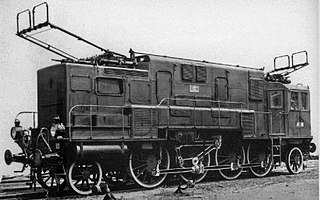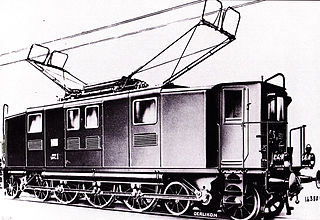This article relies largely or entirely on a single source .(December 2014) |
| Class E.330 | |||||||||||||||||||||||
|---|---|---|---|---|---|---|---|---|---|---|---|---|---|---|---|---|---|---|---|---|---|---|---|
 | |||||||||||||||||||||||
| |||||||||||||||||||||||
| |||||||||||||||||||||||
| |||||||||||||||||||||||
| |||||||||||||||||||||||
The FS Class E.330 was a small class of three-phase electric locomotive used in Italy, introduced in the 1910s.
This article relies largely or entirely on a single source .(December 2014) |
| Class E.330 | |||||||||||||||||||||||
|---|---|---|---|---|---|---|---|---|---|---|---|---|---|---|---|---|---|---|---|---|---|---|---|
 | |||||||||||||||||||||||
| |||||||||||||||||||||||
| |||||||||||||||||||||||
| |||||||||||||||||||||||
| |||||||||||||||||||||||
The FS Class E.330 was a small class of three-phase electric locomotive used in Italy, introduced in the 1910s.
In the late 1900s, the success of the three-phase electrification on mountain lines such as the Valtellina line, the Simplon Tunnel and the Giovi Pass line, led the newly formed Ferrovie dello Stato, under the direction of Riccardo Bianchi, to extend the electrification to other lines, where electric locomotives gave better performance. For the new lines to be electrified, three batches of electric locomotives were ordered, including the E.330 and the E.550 (a type E.551 was ordered but not built).
Unlike the previous electric locomotives used on mountain lines, the new locomotives had to be able to vary their speed, a capability which at the time was difficult to achieve, due to the fact that the three-phase motor spins at constant speed set by the feeding current frequency. The E.330 was designed to have four speeds (where the E.430 had only one and the contemporary E.550 two); this capability was obtained thanks to two patents by the German engineer Manu Stern and the Hungarian engineer Maurice Milch. [1] The wheel arrangement chosen was 1′C1′, similar to that adopted on the contemporary 685 class of steam locomotives.
The production contract was signed in 1913, construction of the new units beginning at Società Italiana Westinghouse, which had designed the locomotive under the direction of Kálmán Kandó. The mechanical parts were co-built with Società Italiana Ernesto Breda.
The locomotives were assigned to the Valtellina and Ligurian coast lines. The E.330s became operational in the Spring 1914. They were later used also in Lombardy on the local three-phase lines, until, from 1962, the railroads were adapted to the now standard 3,000 V direct current electrification.
All the E.330s were phased out during the 1960s.

An electric locomotive is a locomotive powered by electricity from overhead lines, a third rail or on-board energy storage such as a battery or a supercapacitor. Locomotives with on-board fuelled prime movers, such as diesel engines or gas turbines, are classed as diesel-electric or gas turbine-electric and not as electric locomotives, because the electric generator/motor combination serves only as a power transmission system.

The E.412 class is a batch of multi-role electric locomotives built for the mountain lines, particularly for the northern Italian lines of the Brenner pass. They are known as Brenner or Brennerlok locomotives. 28 units from both the groups have been acquired by Trenitalia, as part of a process of simplifying rail operation between Italy, Switzerland, Austria and Germany. The locomotives are qualified for running on French rails, too, making the E.412s potentially fit for service on most European lines except the high-speed rail lines.

The Italian railway system is one of the most important parts of the infrastructure of Italy, with a total length of 24,227 km (15,054 mi) as of 2011.

The FS E.625 and E.626 are two classes of Italian electric locomotives produced for the Ferrovie dello Stato. They were introduced in the course of the 1920s and remained in service until the 1990s. The E.626 was the first locomotive fed by 3,000 V DC overhead line in Italy.
Giuseppe Bianchi was an Italian railway engineer on the Ferrovie dello Stato between 1913 and 1946.

The FS Class E.550 was a class of three-phase electric locomotive used in Italy, introduced in the 20th century, which remained in service until 1965.

The Brenner Railway is a major line connecting the Austrian and Italian railways from Innsbruck to Verona, climbing up the Wipptal, passing over the Brenner Pass, descending down the Eisacktal to Bolzano/Bozen, then further down the Adige Valley to Rovereto/Rofreit, and along the section of the Adige Valley, called in Italian the “Vallagarina”, to Verona. This railway line is part of the Line 1 of Trans-European Transport Networks (TEN-T). It is considered a "fundamental" line by the state railways Ferrovie dello Stato (FS).

Three-phase AC railway electrification was used in Italy, Switzerland and the United States in the early twentieth century. Italy was the major user, from 1901 until 1976, although lines through two tunnels also used the system; the Simplon Tunnel between Switzerland and Italy from 1906 to 1930, and the Cascade Tunnel of the Great Northern Railway in the United States from 1909 to 1939. The first standard gauge line was in Switzerland, from Burgdorf to Thun, from 1899 to 1933.
Tecnomasio was an Italian scientific and precision instrument company founded in the 1860s. By the beginning of the 20th century the company has begun to produce electrical equipment. After financial problems in the early 1900s the company was acquired by Brown Boveri becoming Tecnomasio Italiano Brown Boveri commonly known as TIBB; instrument production halted and the company became an industrial electrical equipment producer, one of the major companies in Italy.

The FS E.326 was a class of Italian railways electric locomotives. Designed in 1929, they were introduced in the early 1930s, for hauling light express passenger trains at high speeds.

The FS Class E.360 were electric locomotives of the Italian State Railways (FS), using three-phase alternating current, built for the operation of the Valtellina line. They were ordered by Rete Adriatica and were originally numbered RA 361–363. Italian railways were nationalized in 1905 and they then became FS E.361-363 They were leased to Swiss Federal Railways (SBB) in 1906 and returned to Italy in 1907.

The FS Class E.471 locomotives were prototype three-phase AC electric locomotives designed for the Italian State Railways (FS). They constituted the first Italian experiment in using a phase converter. The final goal was to power them with single-phase alternating current, constituting the first case of a European locomotive of this type designed according to modern criteria. However, the difficulty of the development, and political interference, led to the abandonment of the project.

The Ferrovia Alta Valtellina (FAV) is a railway line in Italy which connects Sondrio, in Valtellina, to Tirano in Alta Valtellina. The railway company was established in 1899 and the line opened in 1902. Many railways in Italy were nationalized in 1905 but the Ferrovia Alta Valtellina escaped and was not nationalized until 1970.

The Ferrovia della Valtellina is a railway line in Italy that runs from Lecco to Valtellina and Valchiavenna. It was opened in 1894 and electrified on the three-phase system in 1902. It is now electrified at 3 kV direct current and operated by Trenord.

The FS Class E.430 locomotives, initially classed as RA 34, were three-phase alternating current electric locomotives of the Italian railways. They were built for Ferrovia della Valtellina by Ganz and MÁVAG in 1901 and had a power output of 440 kW and a haulage capacity of 300 tons. One locomotive is preserved.

The FS Class E.431 was a class of three-phase AC electric locomotives of the Italian State Railways (FS).

FS Class E.432 was a class of three-phase electric locomotives of the Italian State Railways. Forty of these 1′D1′ locomotives were built in 1928 by Società Ernesto Breda and two have been preserved.

FS Class E.332 was a class of three-phase electric locomotives of the Italian State Railways (FS). They were used for the haulage of passenger trains between 1917 and 1963. Designed and built at the same time as the FS Class E.331, they represented an attempt by FS to extend the use of three-phase AC electric traction from primary to secondary routes. Their performance was disappointing and they were relegated to a marginal role, in which they remained despite several modifications.

FS Class E.333 was a class of electric locomotives of the Ferrovie dello Stato (FS), powered by three-phase alternating current, which were in service from 1923 to 1968. They were designed by Kálmán Kandó for hauling fast passenger trains. Having the same electrical equipment as the FS Class E.552 locomotives, they presented the same defects and had to be modified. After modification, they were able to carry out the services for which they were designed.

FAV Class E.440 was a class of four electric locomotives built for the Italian Ferrovia Alta Valtellina (FAV) in 1932 for the operation between Sondrio and Tirano.